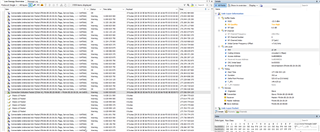Hi,
My simple peripheral example is based on SDK 5.10. I am also using RF Block mode as well. The connection request is made from the BTool with connection interval of 30 ms and Supervision timeout of 2 seconds.
As soon the stack sends GAP_LINK_ESTABLISHED_EVENT in the application, the firmware is calling DMMPolicy_setBlockModeOn() to enable the RF Block mode to ON for almost 200-250 ms before disabling the RF Block mode.
I am seeing that the connection is resulted in termination in case the RF Block mode is ON for 200 ms. If I start using the RF Block after the 1st connection interval rather than enabling it after receiving GAP_LINK_ESTABLISHED_EVENT, the connection is successful.
Is there anything in the BLE stack which requires the 1st connection interval to have RF mode enabled (not RF Block mode)?


